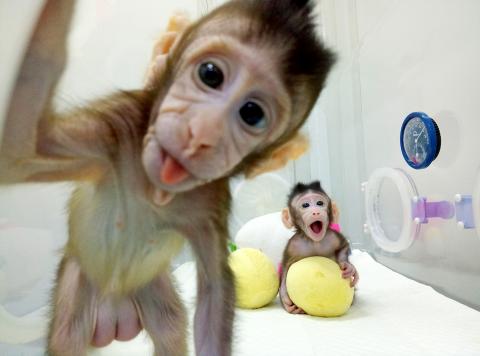Chinese scientists have cloned monkeys using the same technique that produced Dolly the sheep two decades ago, breaking a technical barrier that could open the door to copying humans.
Zhong Zhong (中中) and Hua Hua (華華), two identical long-tailed macaques, were born eight and six weeks ago, making them the first primates — the order of mammals that includes monkeys, apes and humans — to be cloned from a non-embryonic cell.
It was achieved through a process called somatic cell nuclear transfer (SCNT), which involves transferring the nucleus of a cell, which includes its DNA, into an egg which has had its nucleus removed.

Photo: Reuters
Researchers at the Chinese Academy of Sciences Institute of Neuroscience in Shanghai said their work should be a boon to medical research by making it possible to study diseases in populations of genetically uniform monkeys.
However, it also brings the feasibility of cloning to the doorstep of our own species.
“Humans are primates. So [for] the cloning of primate species, including humans, the technical barrier is now broken,” Muming Poo (蒲慕明), who helped supervise the program at the institute, told reporters in a conference call. “The reason ... we broke this barrier is to produce animal models that are useful for medicine, for human health. There is no intention to apply this method to humans.”
Genetically identical animals are useful in research because confounding factors caused by genetic variability in non-cloned animals can complicate experiments. They could be used to test new drugs for a range of diseases before clinical use.
The newborns are being bottle fed and are growing normally.
Researchers expect more macaque clones to be born over the coming months, they said.
Since Dolly — cloning’s poster child — was born in Scotland in 1996, scientists have successfully used SCNT to clone more than 20 other species, including cows, pigs, dogs, rabbits, rats and mice.
However, similar work in primates had always failed, leading some experts to wonder if primates were resistant.
The new research, published on Wednesday in the journal Cell, shows that is not the case.
The Chinese team succeeded, after many attempts, by using modulators to switch on or off certain genes that were inhibiting embryo development.
Even so, their success rate was extremely low and the technique worked only when nuclei were transferred from fetal cells, rather than adult ones, as was the case with Dolly.
In all, it took 127 eggs to produce two live macaque births.
“It remains a very inefficient and hazardous procedure,” said Robin Lovell-Badge, a cloning expert at the Francis Crick Institute in London, who was not involved in the Chinese work. “The work in this paper is not a stepping-stone to establishing methods for obtaining live born human clones. This clearly remains a very foolish thing to attempt.”
The research underscores China’s increasingly important role at the cutting-edge of biosciences, where its scientists have at times pushed ethical boundaries.
Three years ago, researchers at Sun Yat-sen University in Guangzhou caused a furore when they reported carrying out the first experiment to edit the DNA of human embryos, although similar work has now been done in the US.
Scientists at the Shanghai institute said they followed international guidelines for animal research set by the US National Institutes of Health, but called for a debate on what should or should not be acceptable practice in primate cloning.

BACKLASH: The National Party quit its decades-long partnership with the Liberal Party after their election loss to center-left Labor, which won a historic third term Australia’s National Party has split from its conservative coalition partner of more than 60 years, the Liberal Party, citing policy differences over renewable energy and after a resounding loss at a national election this month. “Its time to have a break,” Nationals leader David Littleproud told reporters yesterday. The split shows the pressure on Australia’s conservative parties after Prime Minister Anthony Albanese’s center-left Labor party won a historic second term in the May 3 election, powered by a voter backlash against US President Donald Trump’s policies. Under the long-standing partnership in state and federal politics, the Liberal and National coalition had shared power

NO EXCUSES: Marcos said his administration was acting on voters’ demands, but an academic said the move was emotionally motivated after a poor midterm showing Philippine President Ferdinand Marcos Jr yesterday sought the resignation of all his Cabinet secretaries, in a move seen as an attempt to reset the political agenda and assert his authority over the second half of his single six-year term. The order came after the president’s allies failed to win a majority of Senate seats contested in the 12 polls on Monday last week, leaving Marcos facing a divided political and legislative landscape that could thwart his attempts to have an ally succeed him in 2028. “He’s talking to the people, trying to salvage whatever political capital he has left. I think it’s

CONTROVERSY: During the performance of Israel’s entrant Yuval Raphael’s song ‘New Day Will Rise,’ loud whistles were heard and two people tried to get on stage Austria’s JJ yesterday won the Eurovision Song Contest, with his operatic song Wasted Love triumphing at the world’s biggest live music television event. After votes from national juries around Europe and viewers from across the continent and beyond, JJ gave Austria its first victory since bearded drag performer Conchita Wurst’s 2014 triumph. After the nail-biting drama as the votes were revealed running into yesterday morning, Austria finished with 436 points, ahead of Israel — whose participation drew protests — on 357 and Estonia on 356. “Thank you to you, Europe, for making my dreams come true,” 24-year-old countertenor JJ, whose

Polish presidential candidates offered different visions of Poland and its relations with Ukraine in a televised debate ahead of next week’s run-off, which remains on a knife-edge. During a head-to-head debate lasting two hours, centrist Warsaw Mayor Rafal Trzaskowski, from Polish Prime Minister Donald Tusk’s governing pro-European coalition, faced the Eurosceptic historian Karol Nawrocki, backed by the right-wing populist Law and Justice party (PiS). The two candidates, who qualified for the second round after coming in the top two places in the first vote on Sunday last week, clashed over Poland’s relations with Ukraine, EU policy and the track records of their